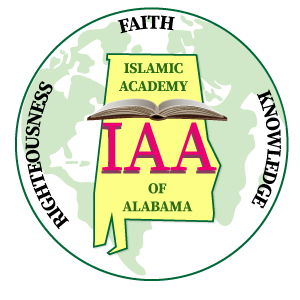Arabic
Students attending Islamic Academy of Alabama are provided with the opportunity to learn Arabic as a Foreign Language starting from preschool to grade 10. The Arabic Language curriculum is based on the American Council on the Teaching of Foreign Language (ACTFL) World Readiness Standards for Learning Languages. The five components of the Standards are; Communication, Cultures, Connections, Comparisons, and Communities. The standards are applicable to all students in Pre-K – 12th grade.
The curriculum throughout all grades focuses on both the academic and social sectors of the Arabic language, focusing in-depth on language skills; reading, writing, listening and speaking. The Arabic language is introduced in an attractive method through the use of stories, songs, dialogues, language games, art, and visual support materials.Students are encouraged to develop STEM skills including researching, typing in Arabic, and creating videos, media clips, and PowerPoint presentations.
Students are given many opportunities throughout the school year to showcase their Arabic language skills including; Arabic Spelling Bee, Arabic Language Day, Arabic Culture Night, and Arabic Reading Program.
Objectives/ACTFL Standards
Communication
- Interpersonal Communication: Learners interact and negotiate meaning in spoken, signed, or written conversations to share information, reactions, feelings, and opinions.
- Interpretive Communication: Learners understand, interpret, and analyze what is heard, read, or viewed on a variety of topics.
- Presentational Communication: Learners present information, concepts, and ideas to inform, explain, persuade, and narrate on a variety of topics using appropriate media and adapting to various audiences of listeners, readers, or viewers.
Cultures
- Relating Cultural Practices to Perspectives: Learners use the language to investigate, explain, and reflect on the relationship between the practices and perspectives of the cultures studied.
- Relating Cultural Products to Perspectives: Learners use the language to investigate, explain, and reflect on the relationship between the products and perspectives of the cultures studied.
Connections
- Making Connections: Learners build, reinforce, and expand their knowledge of other disciplines while using the language to develop critical thinking and to solve problems creatively.
- Acquiring Information and Diverse Perspectives: Learners access and evaluate information and diverse perspectives that are available through the language and its cultures.
Comparisons
- Language Comparisons: Learners use the language to investigate, explain, and reflect on the nature of language through comparisons of the language studied and their own.
- Cultural Comparisons: Learners use the language to investigate, explain, and reflect on the concept of culture through comparisons of the cultures studied and their own.
Communities
- School and Global Communities: Learners use the language both within and beyond the classroom to interact and collaborate in their community and the globalized world.
- Lifelong Learning: Learners set goals and reflect on their progress in using languages for enjoyment, enrichment, and advancement.
